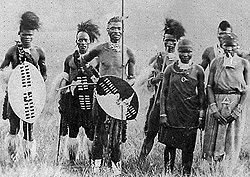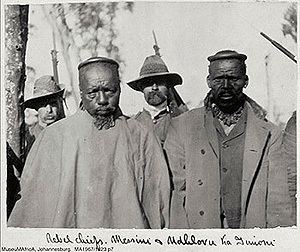36 (including 6 levies) 3,000 to 4,000 killed Result British victory | Date 1906 | |
Colonel Duncan McKenzie Chief Bambatha kaMancinza Similar Anglo‑Zulu War, Ahmed Barzani revolt, Invasion of Ceylon, Pink's War, Siege of Malakand | ||
The Bambatha rebellion was a Zulu revolt against British rule and taxation in Natal, South Africa, in 1906. The revolt was led by Bambatha kaMancinza (c. 1860–1906?), leader of the amaZondi clan of the Zulu people, who lived in the Mpanza Valley, a district near Greytown, KwaZulu-Natal.
Contents

Overview
In the years following the Anglo-Boer War British employers in Natal had difficulty recruiting black farm workers because of increased competition from the gold mines of the Witwatersrand. The colonial authorities introduced a £1 poll tax in addition to the existing hut tax to pressure Zulu men to enter the labour market. Bambatha, who ruled about 5,500 people living in about 1,100 households, was one of the chiefs who resisted the introduction and collection of the new tax.

The government of Natal sent police officers to collect the tax from recalcitrant districts, and in February 1906 two British officers were killed near Richmond, KwaZulu-Natal. In the resulting introduction of martial law, Bambatha fled north to consult King Dinuzulu, who gave tacit support to Bambatha and invited him and his family to stay at the royal homestead.

Bambatha returned to the Mpanza Valley to discover that the Natal government had deposed him as chief. He gathered together a small force of supporters and began launching a series of guerrilla attacks, using the Nkandla forest as a base. Following a series of initial successes, colonial troops under the command of Colonel Duncan McKenzie set out on an expedition in late April 1906.

Once they succeeded in getting face to face with and surrounding the rebels at Mome Gorge, the British victory in the unequal battle was inevitable, given the vast disparity of forces. As the sun rose, colonial soldiers opened fire with machine guns and cannon, on rebels mostly armed only with traditional assegais (spears), knobkerries (fighting sticks) and cowhide shields.
Bambatha was killed and beheaded during the battle; however, many of his supporters believed that he was still alive, and his wife refused to go into mourning. Bambatha's main ally, the 95-year-old Zulu aristocrat Inkosi Sigananda Shezi of the amaCube clan (cousin and near-contemporary of the Zulu king Shaka) was captured by the colonial troops and died a few days later.
Between 3,000 and 4,000 Zulus were killed during the revolt (some of whom died fighting on the side of the Natal government). More than 7,000 were imprisoned, and 4,000 flogged. King Dinizulu was arrested and sentenced to four years imprisonment for treason.
The war cost the Natal government GB£883,576 (equivalent to £370,000,000 in 2010).
Mahatma Gandhi's role
Mohandas Karamchand Gandhi, who was in South Africa at the time, felt that the Indians in South Africa would do best for themselves to serve the British Empire as a reserve force in the Army against the Zulu uprising. Gandhi actively encouraged the British to recruit Indians. He argued that Indians should support the war efforts in order to legitimise their claims to full citizenship. The British, however, refused to commission Indians as army officers. Nonetheless, they accepted Gandhi's offer to let a detachment of Indians volunteer as a stretcher bearer corps to treat wounded British soldiers. This corps of 21 was commanded by Gandhi. Gandhi urged the Indian population in South Africa to join the war through his columns in Indian Opinion: "If the Government only realised what reserve force is being wasted, they would make use of it and give Indians the opportunity of a thorough training for actual warfare." Later in 1927 he wrote of the event as "No war but a man hunt."
Commemoration
In 2006, the hundredth anniversary of the rebellion was commemorated in a ceremony which declared Chief Bambatha a national hero of post-Apartheid South Africa. Also, his picture appeared on a postage stamp and a street was renamed in his honor.
According to speeches in the ceremony, the beheaded body had not really been Bambatha's and the actual chief succeeded in escaping to Mozambique. This belief is still widely current; a DNA test of his alleged body failed to give a definite answer.
